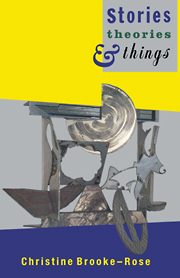Book contents
- Frontmatter
- Contents
- Preface
- Acknowledgements
- Part I Theories as stories
- Part II Stories and style
- Part III Theories of stories
- 10 Fiction, figment, feign
- 11 Which way did they go? Thataways
- 12 Palimpsest history
- 13 Illusions of parody
- 14 Illusions of anti-realism
- 15 A womb of one's own?
- Part IV Things?
- References
- Index
11 - Which way did they go? Thataways
Published online by Cambridge University Press: 20 August 2009
- Frontmatter
- Contents
- Preface
- Acknowledgements
- Part I Theories as stories
- Part II Stories and style
- Part III Theories of stories
- 10 Fiction, figment, feign
- 11 Which way did they go? Thataways
- 12 Palimpsest history
- 13 Illusions of parody
- 14 Illusions of anti-realism
- 15 A womb of one's own?
- Part IV Things?
- References
- Index
Summary
It is a commonplace of contemporary criticism that the character in the novel, as known for generations from a type of criticism, a type of school-teaching and therefore of examination-question, from innumerable fictobiostudies and from the traditional way of reviewing that came out of all that, no longer exists. Some continue as if it did, but the problem is not really one of choice, of ‘you go your way I'll go mine’. Nor is it that certain wicked authors have killed off all characters, or the possibility of characters, so that writers who continue in the old mode somehow can't produce convincing ones any more. It is that the whole concept of character in the novel has changed, and while some writers have noted the fact and mimed it or played with it, others have ignored it.
Character A to Z
Over twenty years ago, John Barth was already dissolving characters in ‘Life-Story’, a chapter of Lost in the Funhouse (1968, 117–21):
D comes to suspect that the world is a novel, himself a fictional personage […] since D is writing a fictional account of this conviction […] Moreover E, hero of D's account, is said to be writing a similar account […] If I'm going to be a fictional character G declared to himself […] If he can only get K through his story I reflected grimly […] Why could he not begin his story afresh et cetera? Y's wife came into the study.
- Type
- Chapter
- Information
- Stories, Theories and Things , pp. 167 - 180Publisher: Cambridge University PressPrint publication year: 1991



